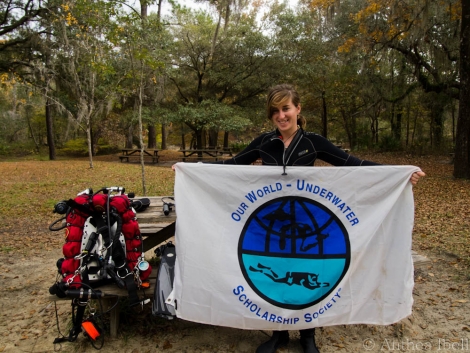After completing my Cavern and Basic Cave course with Jill Heinerth, I stayed in North Florida to put my new training into practice. Unfortunately an ear infection delayed my plans. While confined to dry land for a week I filled my time with other interesting activities.
I attended ‘A Karst Conversation’ – a great workshop hosted by the Karst Conservancy and Hoffman Environmental Research Institute that
addressed the importance of Florida’s freshwater supply. 25% of the fresh water used in the US each year is from Florida’s aquifers. This fact alone shows the importance of conserving these water systems. The workshop covered the basic geology of the karst environment in Florida as well as presented solutions to minimise pollution. Karst is a region characterised by sinkholes, underground streams and caverns and are typically formed by acidic rain water dissolving soluble bedrock. As all of the sinkholes, streams and springs are connected through underground channels, this makes the whole water supply vulnerable to contamination by runoff and other pollutants. The Karst Conservancy is working to protect this water by directly acquiring karst properties in order to preserve recharge zones (where the water percolates into the ground), they also implement long term management plans and educate the public through workshops such as the one that I attended and by giving guided tours of local caves.
[youtube BoypPMbSLp4 550 309]
Above is a short video by Circle of Blue that will make you think about your water use.
I was also fortunate enough to attend a climbing and caving clinic hosted by the South Eastern Cave Conservancy (SCCi) and run by Walter Pickel from the ADM Exploration Foundation, where I was able to gain real world experience in a dry cave in Central North Florida. The
rope skills and caving techniques I learnt during the clinic were only introductory and I would be interested in gaining more training in these areas in the future to eventually participate in sump diving. Sump diving involves caves that are both wet and dry so require a lot of skills and experience in cave diving, caving and climbing.
After the antibiotics kicked in and my ears cleared, I was able to get back in the water and into some caves! Riana Treanor; a great cave diver, photographer and friend, took me to Madison Blue Springs for a dive into the stunning cave system. I donned my doubles and climbed down the path to the crystal clear blue water, which is a constant 72°F/22°C year round. We descended down into the cavern and as the sunlight disappeared the blue luminescence from the dive lights lit up the corridor. I followed Riana as she laid our line. She tied off at the ‘main line’ which is a permanent gold line running through the main corridor of the cave. We ventured further into the cave and passed through what are technically non restrictions, but to my novice perception seemed small. The caves of Florida are truly beautiful – even though scary at first, the dark open passages ahead seem inviting.
Thank you to Riana Treanor for all her generosity, help and support. Riana hosted me for two weeks and showed me some of the most beautiful areas of Florida. Thanks to Walter Pickel for his help with the dry cave training and the ADM Exploration Foundation for their support. O course, thanks again to Jill Heinerth for infinite wisdom and incredible generosity.












Anthea, it was an absolute pleasure meeting you and working on climbing / caving with you — you are a “natural”. Good luck with your exploration under and on this amazing blue marble!